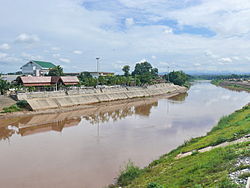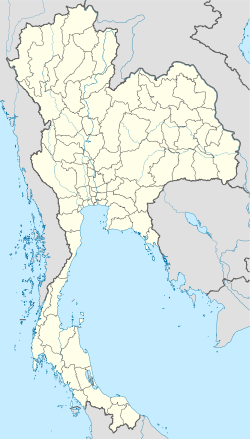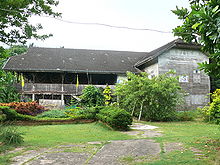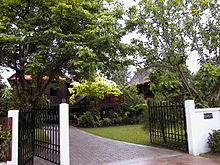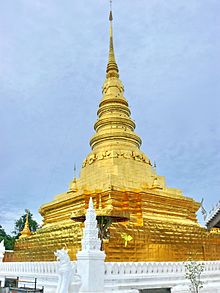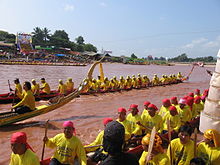- Nan, Thailand
-
Nan
น่านThe Nan river in the city of Nan Coordinates: 18°47′N 100°47′E / 18.783°N 100.783°ECoordinates: 18°47′N 100°47′E / 18.783°N 100.783°E Country Thailand Province Nan Nan (Thai: น่าน) is a town in Northern Thailand. It is located some 668 km north of Bangkok. Its population exceeds 24.000. It is situated in the centre of the province which bears its name, and of which it is the administrative capital. It covers the whole tambon Nai Wiang of Mueang Nan district, an area of 5.40 km². As of 2005 it had a population of 20,413. It is subdivided into 26 chumchon. It is spread out along the Nan river's right bank. Nan is a small city, primarily devoted to commercial, administrative, educational and hospital activities. The old heart of the city, where Wat Phumin, the National Museum and other tourist attractions are located, is being restored. The city's industrial and tourist development remains limited until now, but should be improved by the complete opening of the border towards Laos and beyond towards China, an opening that has been postponed so far but should occur in a short time.
Contents
History
Little-known Nan goes back to the depths of the history of Thailand. For centuries it was a separate, autonomous kingdom with few relationships with the outside world.
There is much evidence of prehistoric habitation, but it wasn't until several small mueang united to form Nanthaburi on the Nan river in the mid-14th century - contemporary with the creation of Luang Prabang and the Lan Xang (Million Elephants) kingdom in Laos - that the city became a power to be taken into account. Associated with the mighty Sukhothai kingdom, the mueang took the title Wara Nakhon and played a significant part in the development of early Thai nationalism.
By the end of the -14th century Nan was one of the nine northern Thai-Lao principalities that comprised Lan Na Thai (now Lanna) and the city state flourished throughout the 15th century under the name Chiang Klang (Middle City), a reference to its position roughly midway between Chiang Mai (New City) and Chiang Thong (Golden City, which is today's Luang Prabang). The Burmese took control of the kingdom in 1558 and deported many of the inhabitants to Burma as slaves; the city was completely deserted until western Thailand was retaken from the Burmese in 1786. The local dynasty then regained local sovereignty and it remained semi-autonomous until 1931 when Nan finally accepted full Bangkok dominion. Parts of the old city wall and several early wats dating from the Lanna period can be seen in contemporary Nan. The city of Nan's wats are distinctive: some temple structures show Lanna influence, while others belong to the Thai Lue legacy brought from Xishuangbanna in China, where the Thai Lue people came from.
Nan National Museum
The Nan National Museum is located in the original palace of the last two feudal lords of Nan. The building was originally constructed in 1903 by Phra Chao Suriyapnong Phalidet, the last but one lord of Nan to replace his former wooden residence. After the death of the Chao Maha Brahma Surathada, the last lord of Nan, his heirs donated this palace to the government in 1931 in order to be used as the provincial hall. The museum (Pha Kong road; admission 30B; 9am-4pm Mon-Sat) was inaugurated in 1973 after the new provincial hall building had been erected. Thanks to relatively recent renovations, it is one of Thailand's most up-to-date provincial museums and, unlike many others, it also has English labels for many items on display. The ground level is divided into six exhibition rooms with ethnological exhibits dealing with the various ethnic groups round in the province, including the northern Thais, Thai Lue, Htin, Khamu, Mabri, Hmong and Mien. Silverwork, textiles, folk utensils and tribal costumes can be found on display. Exhibits on Nan history, archaeology, local architecture, royal regalia, weapons, ceramics and religious art are shown on the second floor, divided into two sections. The first is the main hall which used to be the throne hall of the feudal lord. The second consists of the rooms in the north and south wings. The museum exhibits a wide collection of Buddha images which include some rare Lanna styles as well as the floppy-eared local styles. Usually made from wood, these standing images are in the calling for rain' posture (with hands at the sides, pointing down) and they show an obvious Luang Prabang influence. Also on display on the 2nd floor is a rare black (in fact reddish-brown) elephant tusk said to have been offered to a Nan king over 300 years ago by the Khün lord of Chiang Tung (Kengtung). Held aloft by a wooden Garuda (mythical bird) sculpture, the tusk measures 97 cm long and 47 cm in circumference. Books on Thai art and archaeology are sold in a building adjacent to the museum.
King of Nan's Teak House
Built in 1866 with golden teak and reconstructed in 1941, this large house (Mahaprom road, opposite the rear entrance of the Wat Phra That Chang Kham) is now the residence of Chao Sompradhana Na Nan. It exhibits heritage antiques such as ancient weapons, war elephant ivory and photographs by King Rama V. Contact the owner for visiting (Tel. 0 5471 0605).
The House of Chao Fongkham
This is a large, rambling teak house in classic Northern Thai style set in a beautiful garden. Chao Fongkham was a descendant of Chao Anantaworarithidej, the 62nd Lord of Nan and the father of the last two Lords. The oldest parts of the house show planks formed by axe and knife, before large saws were available in Nan. At the time it was built, about 150 years ago, such large teak houses were reserved for the nobility. It is probably the best preserved such noble house in the whole province. Originally erected in the area of Nan now occupied by the military camp, it was moved to its current site, on a quiet soi behind Wat Pragert, by Chao Fongkham's parents, about 100 years ago. It is now occupied by Chao Fongkham's children. To visit, please call 054 710 537.
The Old Wall
Constructed in 1885 by Chao Anantavorarittidet, Nan's ruler, the wall was built in place of an old log wall destroyed by flood in 1817. Remnants of the wall - around 400 m out of the original 3 600 m - can be seen at the junction of Mahawong road and Rob Muang road, at the South-Western end of the town.
Religious Sites
Wat Phumin
Main article: Wat PhuminThe city of Nan's most famous wat is renowned for its cruciform ubosoth (or bot) which was constructed in 1596 and restored during the reign of Chao Ananta Vora Ritthi Det (1867-1875). It is the only temple which was built as if it were on the back of two immense snakes (or Nagas). Each of the four entrances is preceded by a small corridor topped by a finely decorated point shaped structure (underlining the royal origin of the temple) and is equipped with smoothly carved doors; with Chinese demon guards in the East, flowers in the North and forest life motives in the Lanna style in the West and South. The wat's interior is impressive. It is also a good example of Thai Lue architecture. Well preserved murals of great value illustrating the Khattana Kumara Jataka on the Northern wall and the Nimi Jatakas on the Western wall as well as scenes of the local life of the time when they were painted by Thai Lue artists during the restoration of the temple at the end of the 19th century. Europeans can even be noticed: a reference to the arrival of the French to whom the East of the Nan valley area was yielded in 1893.
Wat Phra That Chae Haeng
Two kilometers past the bridge that spans the Nan river, heading southeast out of town, this temple dates from 1355 and was built during the reign of Pray Kan Muang. It is the most sacred wat in Nan Province. It is set in a square, walled enclosure on top of a hill with a view of Nan and the valley. The Thai Lue influenced bot features a triple-tiered roof with carved wooden eaves and dragon reliefs over the doors. A gilded Lanna-style chedi sits on a large square base next to the bot, its sides 22.5m long; the entire stupa is 55.5m high.
Wat Phra That Chang KhamAfter Wat Phra That Chae Haeng, this wat (Pha Kong road) is the second-most important temple in the city. The main wihan, constructed in 1458, has a huge seated Buddha image and faint murals. Also in the wihan, is a set of Lanna-period scrolls inscribed (in Lanna script) not only with the usual Buddhist scriptures but also with the history, law and astrology of the time. A thammdat (a dhamma seat used by monks when teaching) sits to one side. The magnificent chedi behind the wihan dates to the 14th century, probably around the same time the temple was founded. It features 24 elephant supports similar to those seen in Sukhothai and Si Satchanalai. Next to the stupa is a small, insignificant bot from the same era. Wat Phra That Chang Kham is also eminent by having the largest hàw trai (Tripitaka library) in Thailand but it is now empty.
 Wat Hua Khuang (Haw Trai, chedi, and bot Nan
Wat Hua Khuang (Haw Trai, chedi, and bot Nan
Wat Hua Khuang
This small wat diagonally opposite Wat Phra That Chang Kham is composed of a distinctive Lanna/Lan Xang-style chedi with four Buddha niches, a wooden hàw trai - now used as a kùti (monk cell) - and a noteworthy bot with a Luang Prabang-style carved wooden veranda. A carved wooden ceiling and a huge Naga altar can be found inside. Stylistic cues suggest this may be one of the city's oldest wats though the temple's founding date is unknown.
Wat Suan Tan
Supposedly established in 1456, the Wat Suan Tan (Palm Grove Monastery; Suan Tan road) is composed of an interesting chedi of the 15th century (40 m high) which combines Hindu/Khmer style motives (chedi in the form of a prang) and, surmounting it, an obviously Sukhothai style motive in the shape of a lotus bud, modified in its current form in 1914. The heavily restored wihan contains the Phra Chao Thong Thipun, out of early Sukhothai-style bronze, seated Buddha in the pose of Bhūmisparsa mudrā. It measures 4.10 meters and could have been ordered by the Chiangmai sovereign Tilokaraj following his conquest of Nan in 1449.
Boat racing
For centuries, longboat racing has been held annually in provinces with a major waterway running through them. Long-boat racing is one of the traditional rites which commemorates the end of the Buddhist Rains Retreat. It takes place mainly in the 10th and/or 11th lunar months (around September/October) when the water level is at its peak. At present, long-boat racing is considered a national sport. Its history can be traced back to the Ayutthaya period, some 600 years ago. In that time, boat racing was only a way to keep boat teams fit for national defense.
Racing boats are usually made from dugout tree trunks and can accommodate up to 60 oarsmen (commonly dressed in the same colour) in a double row. The festival event attracts hundreds of spectators. Trophies and prizes are given to the winning teams at the end. The races on the Nan river are colourful and unequalled because the racing boats are brightly adorned with imaginatively designed prows. The cheering squads on the river bank are usually rumbustious and joyful.
Transportation
Nan is connected by plane and by bus to the rest of the country. Happy Air and Solar Air offer flights between Nan Airport and Bangkok. SGA Airlines connects Chiang Mai to Nan. By road, it takes from 10 to 13 hours, according to the type of bus, to travel from Nan to Bangkok. Regular buses also run from Nan to Chiang Mai, Chiang Rai and Phrae.
The local means of transport include songthaew, motorbike-taxis and trishaws.
Gallery
-
Murals in Wat Phumin
External links
Categories:- Nan Province
- Populated places in Thailand
Wikimedia Foundation. 2010.

